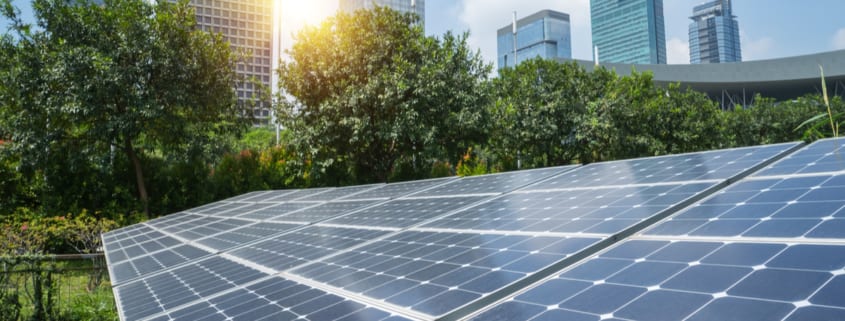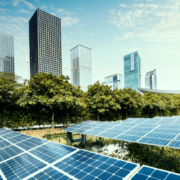3 Methods to Reduce CRE’s Carbon Footprint for Future Sustainability
Today, commercial real estate properties account for nearly 1/5 of the total energy consumption in the United States. Consequently, as much as 30% of that energy is being used either inefficiently or unnecessarily, indicating that there is indeed room for the industry to reduce its carbon footprint. But why is reducing the carbon footprint so important?
Considering the amount of energy consumed by the commercial real estate industry alone, coupled with the Intergovernmental Panel on Climate Change’s (IPCC) prediction that we will experience a drastic climate change in about 14 years, it is more important than ever for our industry to acknowledge its corporate social responsibility and work towards a reduced footprint.
Additionally, with new legislations being passed in an attempt to regulate carbon emissions, developers and owners of energy-efficient properties are positioned to be “ahead of the curve” – and free from potentially paying millions of dollars in emission-related fines.
Read ahead to discover three ways that the industry’s carbon footprint can be reduced and how it will impact the future outlook of CRE.
Install High-Efficiency Lighting
Lighting is typically the largest portion of electricity usage in commercial buildings, accounting for about 17% of electricity and consuming as much as 25-30% of the building’s total energy. With lighting consuming such an excessive amount of energy, making a few minor adjustments could significantly reduce the industry’s carbon footprint – and monthly operating expenses.
Installing high-efficiency lighting, such as compact fluorescent lights (CFLs) or light emitting diodes (LEDs), is a simple, yet cost-efficient method for reducing the amount of energy used within a building. CFLs save 75% of energy because they require less electricity to produce light than traditional incandescent lighting, and LEDs can use as little as 20-25% of energy as that of traditional bulbs.
Building occupants can further increase the impact of these high-efficiency lighting alternatives by changing their habits and having a clear understanding of how the building is being utilized. Encouraging tenants and occupants to make minor habit changes, such as turning off lights in a vacant room or using occupancy sensors and timers in common areas can further help to reduce the industry’s footprint.
Leverage Renewable Energy
Leveraging renewable energy is another method being used in an effort to minimize the industry’s carbon footprint. In fact, Bloomberg’s New Energy Outlook predicts that, by 2050, wind and solar energy will surge to account for about 50% of the world’s energy generation. The use of solar energy, in particular, is gaining traction industry-wide because of its ability to generate power without giving off any emissions. Additionally, solar energy reduces the demand for fossil fuels, which are expensive and harmful to the environment. And with commercial properties accounting for up to 75% of the nation’s carbon emissions, solar energy’s “zero-emission” style points to an effective solution.
Renewable energy is an energy-saving source that has been more readily adopted by CRE firms. Not only do solar panel installations allow firms to support a healthy environment, but it also allows them to publicly display their commitment to “being green” to both current and future tenants. As younger renters increasingly become eco-conscious, solar power is growing as a desirable tenant amenity.
Additionally, the installation of solar panels can be quite scalable. These panels allow firms to leverage otherwise unusable space, such as the roof, parking lot, or field, while increasing the value of the property. Firm owners can also receive federal and state tax credits in many states throughout the U.S. by installing solar power energy systems and supporting the growth of solar energy.
Incorporate Efficient HVAC Systems
According to the U.S. Department of Energy, as much as 50% of a commercial building’s energy is used to operate its HVAC system. The majority of commercial properties are ventilated with outside air, which needs to be heated and cooled to keep the inside air fresh, resulting in an excessive amount of wasted energy. Often, this ventilation occurs even when it is unneeded, which also contributes to the wasted energy produced by traditional HVAC systems.
Higher-efficiency HVAC systems, such as a Variant Refrigerant Flow (VRF) system, can tremendously reduce a building’s carbon footprint when properly installed. HVAC systems like VRF can provide both heating and cooling at the same time, and can potentially reduce a buildings HVAC-related energy consumption by 30-40%.
Additionally, installing indoor air quality systems as part of a building’s HVAC system can help in determining how much ventilation is actually needed so that excess heat and air are not being produced. Ultimately, energy-efficient HVAC systems require less electricity and natural gas, resulting in lower energy bills and a reduced carbon footprint.
Future Outlook for CRE
Planning for reducing the industry’s carbon footprint should occur as early in the development process as possible. A prime time to plan for this reduction is during the sourcing of building materials. Some examples of alternative methods for construction include using recycled goods to make materials, developing concrete that absorbs carbon dioxide, and even using algae for carbon emission absorption.
Sustainable practices are more highly regarded by investors than ever before. They are increasingly viewing global sustainability challenges as central to a property’s long-term financial performance, driving them to seek more information about their funds’ environmental, social, and governance programs prior to making an investment decision.
In 2018, the Greenprint Performance Report revealed the industry’s strides towards reducing its carbon footprint, reporting reductions of 0.6% in water consumption, 0.1% in energy consumption, and 0.8% in electricity. Acknowledging the industry’s corporate social responsibility and working to reduce its carbon footprint through energy-conserving methods will help to ensure a sustainable future for commercial real estate.
Read CRE Sustainability Initiatives of the Future to learn more about how sustainability is driving the future of the industry.






